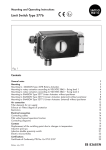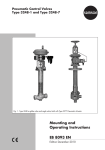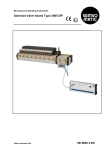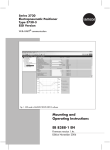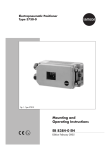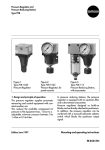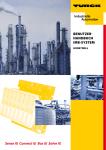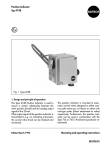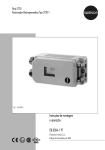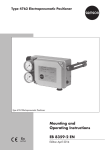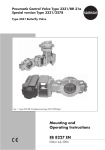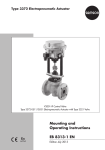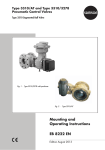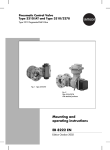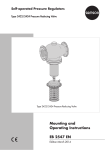Download Mounting and Operating Instructions EB 8359-2 EN
Transcript
Electropneumatic Positioner Type 4763 Fig. 1 · Type 4763 Mounting and Operating Instructions EB 8359-2 EN Edition September 2004 Contents Contents 1 Design and principle of operation . . . . . . . . . . . . . . . . . . . . 6 2 2.1 2.2 2.3 Attachment . . . . . . . . . . . . . . . Attachment to valves with cast yokes . . . Attachment to valves with rod-type yokes Cover of the positioner case . . . . . . . 3 3.1 3.2 3.2.1 3.2.2 Connections . . . . . . Electrical connections . Pneumatic connections . Pressure gauges . . . . Supply pressure . . . . . . . . . . . . . . . . . . . . . . . . . . . . . . . . . . . . . . . . . . . . . . . . . . . . . . . . . . . . . . . . . . . . . . . . . . . . . . . . . . . . . . . . . . . . . . . . . . . . . . . . . . . . . . . . . . . . . . . . . . . . . . . . . . . . . . . . . . . 10 10 11 11 11 4 4.1 4.1.1 4.2 4.3 4.3.1 4.3.2 4.3.3 4.4 Operation . . . . . . . . . . . . . . . . . . . . . . . . . . . . . . Combining positioner and actuator. . . . . . . . . . . . . . . . . . Determining/reversing the operating direction . . . . . . . . . . . . Starting point and input signal (reference variable) . . . . . . . . . . Setting the positioner at the valve. . . . . . . . . . . . . . . . . . . Setting the air delivery (volume restriction Q) and proportional band XP Setting actuator version “Stem extends” . . . . . . . . . . . . . . . Setting actuator version “Stem retracts” . . . . . . . . . . . . . . . . Exchanging the range spring. . . . . . . . . . . . . . . . . . . . . . . . . . . . . . 12 12 12 14 15 15 16 16 17 5 Conversion from electropneumatic to pneumatic positioner. . . . . . . 18 6 Servicing explosion-protected devices . . . . . . . . . . . . . . . . . 19 7 Accessories and mounting parts . . . . . . . . . . . . . . . . . . . . 19 8 Dimensions in mm . . . . . . . . . . . . . . . . . . . . . . . . . . . 20 . . . . . . . . . . . . . . . . . . . . . . . . . . . . . . . . . . . . . . . . . . . . . . . . . 8 8 9 9 Test certificates . . . . . . . . . . . . . . . . . . . . . . . . . . . . 21 2 EB 8359-2 EN Safety instructions 4 Assembly, start-up and operation of the device may only be performed by trained and experienced personnel familiar with this product. According to these mounting and operating instructions, trained personnel is referred to as individuals who are able to judge the work they are assigned to and recognize possible dangers due to their specialized training, their knowledge and experience as well as their knowledge of the relevant standards. 4 Explosion-protected versions of this device may only be operated by personnel who have undergone special training or instructions or who are authorized to work on explosion-protected devices in hazardous areas. 4 Any hazards which could be caused by the process medium, the signal pressure and moving parts of the control valve are to be prevented by means of the appropriate measures. 4 If inadmissible motions or forces are produced in the actuator as a result of the level of the supply air pressure, this must be restricted by means of a suitable pressure reducing station. 4 Proper shipping and appropriate storage are assumed. 4 Note! The device with a CE marking fulfils the requirements of the Directives 94/9/EC (ATEX) and 89/336/EEC (EMC). The declaration of conformity can be viewed and downloaded on the Internet at http://www.samson.de. EB 8359-2 EN 3 Versions Positioner Type Explosion protection Without 4763- x 0 1 x 0 0 x x x x 0 0 II 2 G EEx ia IIC T6 acc. to ATEX 1 Ex ia CSA/FM 3 II 3 G EEx nA II T6 acc. to ATEX 8 Range spring 1 1 2 2 3 3 Pneumatic connections G ¼ ¼ NPT Electrical connections Reference variable 4 EB 8359-2 EN 1 3 M 20 x 1.5 blue 1 M 20 x 1.5 black 2 Harting connector 5 4 to 20 mA 1 1 0 to 20 mA 2 2 1 to 5 mA 2 3 Technical data Controlled variable (travel) Reference variable Split-range 0 to 50 % or 50 to 100 % Reference variable span (up to 50 mm travel) 7.5 to 60 mm, with 90 mm lever extension 4 bis 20 mA Ex Internal resistance Ri at 20 °C approx. 250 Ω ± 7 % 4 bis 20 mA not Ex Internal resistance Ri at 20 °C approx. 200 Ω ± 7 % 0 to 20 mA The data specified in the Certificate of Conformity must be taken into consideration for devices with type of protection EEx II C. Range spring See table on page 14 for selection Supply air 1.4 to 6 bar (20 to 90 psi) Air quality as per ISO 8573-1: Max. particle size and density: Class 4 Oil contents: Class 3, Pressure dew point: Class 3 Signal pressure pst (output) Max. 0 to 60 bar (0 to 90 psi) Characteristic Linear characteristic Deviation from terminal-based conformity: ≤ 1.5 % Hysteresis < 0.5 % Sensitivity < 0.1 % Operating direction Reversible Proportional band XP at 1.4 bar supply air 1 to 3 % with spring 1 and 2 1 to 1.5 % with spring 3 Air consumption in steady state XP = 1 % With 1.4 bar supply air: 0.19 mn3/h Air delivery Transit time with Type 3271 Actuator, stem extends At ∆p 1.4 bar: 3.0 mn3/h With 6 bar supply air: 0.5 mn3/h At ∆p 6 bar: 8.5 mn3/h 240 cm2 ≤ 1.8 s · 350 cm2 ≤ 2.5 s · 700 cm2 ≤ 10 s Permissible ambient temperature –20 to 70 °C –35 to 70 °C for devices with metal cable entry –45 to 70 °C special version Version with oxygen as operating medium up to max. 60 °C Specifications in Certificate of Conformity additionally apply for Ex devices Influences Temperature: < 0.03 %/1 K Supply air: < 0.3 %/0.1 bar Vibration: < 2 % between 10 to 150 Hz and 4 g Effect when turned by 180°: < 3.5 % Degree of protection IP 54, special version: IP 65 Weight Approx. 1.2 kg Materials Case: Die-cast aluminum, chromated and plastic-coated External parts: Stainless steel EB 8359-2 EN 5 Design and principle of operation 1 Design and principle of operation tional change of the air pressure pe sent to the pneumatic control system. The air pressure pe, in turn, produces a force which acts on the surface of the measuring diaphragm (8) and is compared to the force of the range spring (6). The motion of the diaphragm (8) is transferred to the flapper (10.2) via the feeler pin (9.1), and the nozzle (10.1) releases pressure. Any change of either the air pressure pe or the valve stem position causes the pressure to change in the booster (12) connected downstream of the nozzle. The signal pressure pst which is released causes the plug stem to assume a position based on the input signal. The electropneumatic positioner is used for the correlation between the valve stem position (controlled variable x) and the input signal (reference variable w) received from the controller. In this case, the input signal accepted from the control device is compared to the travel (valve stem position) of the control valve, and a pneumatic signal pressure (output variable y) is delivered. The positioner consists of an i/p converter unit (21) and the pneumatic section including the lever (1), shaft (1.1) and range spring (6), plus the control system composing nozzle, flapper and booster. The input signal (e.g. 4 to 20 mA) is directly fed to the i/p converter unit and converted to a proportional air pressure signal pe. Any change of the input current signal causes a propor- The adjustable volume restriction Q (14) and Xp (gain) restriction (13) are used to optimize the control loop. The range spring (6), which can be exchanged, is assigned to both the rated valve travel and the nominal voltage of the input signal. 4 5 6.1 6 3 1 15 8 21 Fig. 2 · Positioner with cover removed 6 EB 8359-2 EN 14 13 10.2 7 Design and principle of operation 1 1.1 2 2.1 20 4 5 6 8 9 Travel 9.1 10.2 10 10.1 6 11 8 9 12 pst Output 36 Supply 9 10 i Legends for Figs. 2 and 3 1 1.1 2 2.1 3 4 5 9.1 14 10.2 13 10.1 Lever for valve travel Shaft Pin Nut Sleeve Zero adjustment screw Mounting screw Fig. 3 · Functional diagram i p pe Arrangement of nozzle/flapper for reverse <> operating direction 21 6 6.1 7 8 9 9.1 10 Range spring Bracket Mounting screw Measuring diaphragm Diaphragm plate Feeler pin Nozzle block 10.1 10.2 11 12 13 14 15 20 21 Nozzle Flapper Cover plate Booster XP restriction Volume restriction Q Borehole for mounting screw Plate i/p converter unit EB 8359-2 EN 7 Attachment 2 Attachment To attach the positioner to valves with cast yokes, mounting parts (order no. 1400-5745) are used. For valves with rod-type yokes (pillars), the mounting kit (order no. 1400-5745) and additionally the mounting kit (order no. 1400-5342) are necessary (see also accessories table on page 19). Since the positioner can be attached on either side of the valve, the physical location (left or right attachment) should be determined before actual attachment (see corresponding Figs. 7 to 10 in section 4.1). 2.1 Attachment to valves with cast yokes 1. Fasten the plate (20) to the stem connector clamps (22) of the valve using the screws (21). 2. Unscrew the positioner cover, and secure the device to the valve yoke using the mounting screw (15). Make sure that the pin (2) is led inside the wire strap and therefore clamped against the plate (20). Legends for Figs. 4 and 5: 1 2 2.1 15 20 21 22 23 24 26 27 28 15 1 20 2 2.1 21 22 23 Fig. 4 · Attachment to valves with cast yokes (NAMUR rib) 8 EB 8359-2 EN Lever Pin Nut Mounting screw Plate Screw Stem connector Plug stem Travel indicator Clamping plate Valve pillars Support Attachment 2.2 Attachment to valves with rod-type yokes 1. Screw the plate (20), off-centered, to the travel indicator (24) of the plug stem (23) using the screws (21). 2. Place both the support (28) and the clamping plate (26) on the pillar (27) and lightly fasten. Move the support until both the center of the plate (20) and the support (28) are aligned at half the valve travel. 4. Mount the positioner to the support using the mounting screw (15). Make sure that the pin (2) is led inside the wire strap and therefore clamped against the plate (20). 2.3 Cover of the positioner case After attaching the positioner, make sure that the vent plug on the cover of the positioner case points downwards after the valve has been installed. 3. Screw tight the support and clamping plate. 15 1 28 27 26 20 2.1 2 21 24 23 Fig. 5 · Attachment to valves with rod-type yokes EB 8359-2 EN 9 Connections 3 Connections 3.1 Electrical connections For electrical installation, you are required to observe the relevant electrotechnical regulations and the accident prevention regulations that apply in the country of use. In Germany, these are the VDE regulations and the accident prevention regulations of the employers' liability insurance association. The following standards apply for installation in hazardous areas: EN 60079-14: 2003 (VDE 0165 Part 1) "Electrical apparatus for explosive gas atmospheres" and EN 50281-1-2: 1999 (VDE 0165 Part 2) "Electrical apparatus for use in the presence of combustible dust". For the interconnection of intrinsically safe electrical equipment, the permissible maximum values specified in the EC type examination certificate apply (Ui or U0; Ii or I0; Pi or P0; Ci or C0, and Li or L0). Note for Zone 2 and Zone 22 equipment : For EEx nA equipment (non-sparking apparatus), the standard EN 50021: 1999 specifies that connecting, interrupting, or switching circuits while energized is only allowed during installation, maintenance or repair work. For EEx nL equipment (energy-limited apparatus), the standard EN 50021: 1999 allows this type of equipment to be switched under normal operating conditions. Caution! The terminal assignment specified in the certificate must be adhered to. Reversing the assignment of the electrical terminals may cause the explosion protection to become ineffective! Do not tamper with enameled screws inside or on the housing. Note on the selection of cables and wires: To install intrinsically safe circuits, observe section 12 of the standard EN 60079-14: 2003 (VDE 0165 Part 1). To run multi-core cables or lines with more than one intrinsically safe circuit, section 12.2.2.7 of this standard applies. An additional cable gland can be installed when connecting the device over two separate cables. Cable entries left unused must be sealed with blanking plugs. Devices used at ambient temperatures down to –40 °C must have metal cable entries. Input Control signal 4 (0) to 20 mA Fig. 6 · Electrical connection 10 EB 8359-2 EN Connections The wiring for the input signal is led using cable glands to the terminals 11 (+) and 12 (–). The ground connection can be connected inside or outside of the positioner case. The following accessories are available: Cable gland M 20 x 1.5 Black Order no. 1400-6985 Blue Order no. 1400-6986 Adapter M 20 x 1.5 to ½ NPT: Aluminum, powder-coated Order no. 0310-2149 3.2 Pneumatic connections The pneumatic connections are designed as tapped holes with ¼ NPT or ISO 2228/1G ¼ thread. The conventional male connections for metal and copper pipes (or plastic hoses) can be used. Note! The supply air must be dry and free of any oil and dust. Always observe the maintenance instructions applicable to the connected pressure reducing stations. Blow out air lines thoroughly before connecting them. 3.2.1 Pressure gauges We recommend attaching pressure gauges for the supply air and signal pressure in order to monitor the positioner. The parts are listed as accessories in the table on page 19. 3.2.2 Supply pressure The required supply pressure is determined by the bench range and the operating direction (fail-safe action) of the actuator. The bench range is written on the nameplate as spring range or signal pressure range depending on the type of actuator. FA (actuator stem extends) or FE (actuator stem retracts) or a symbol indicates the operating direction. Actuator stem extends (FA) Fail-safe position "Valve CLOSED" (for globe and angle valves) Required supply pressure = Upper bench range value + 0.2 bar, minimum 1.4 bar. Actuator stem retracts (FE) Fail-safe position "Valve OPEN" (for globe and angle valves) The required supply pressure for a tight-closing valve is roughly estimated from the maximum signal pressure pstmax: d2 ŸpŸ Dp pstmax = F + [bar] 4Ÿ A d = Seat diameter [cm] ∆p = Differential pressure at the valve [bar] A = Actuator diaphragm area [cm2] F = Upper range value of the actuator In the absence of such specifications, proceed as follows: Required supply pressure = Upper bench range value + 1 bar The positioner output pressure is led to the top or bottom diaphragm case of the actuator as shown in Figs. 7 to 10. EB 8359-2 EN 11 Operation 4 Operation 4.1 Combining positioner and actuator The arrangement of the actuator, input signal, operating direction and mounting location is schematically represented in Figs. 7 to 10. Each subsequent change such as reversal of the control loop's operating direction or field reversing the actuator version from direct "Actuator stem extends" to reverse "Actuator stem retracts" or vice versa also involves changing the mounting location of the positioner. 4.1.1 Determining/reversing the operating direction (Figs. 7 to 11) When the input signal (reference variable w) increases, the signal pressure pst can either be increasing (direct operating direction <<) or decreasing (reverse operating direction <>). The same applies to a decreasing input signal; the output pressure either decreases (direct operating direction <<) or increases (reverse operating direction <>). Symbols are located on the flapper (10.2) which identify the respective operating directions (direct << or reverse <>). 12 EB 8359-2 EN Depending on the flapper position, the adjusted operating direction is marked with the corresponding symbol. If the operating direction of the required function does not match the symbol or if the operating direction is to be changed, proceed as follows: 1. Remove both screws of the cover plate, and lift off the nozzle block (10) along with the cover plate. 2. Reinstall the nozzle block turned 180° together with the cover plate, and screw tight. Make sure that the nozzle block and flapper are correctly located above or below the feeler pin (9.1) as shown in Fig. 11. If the operating direction is to be changed after the initially determined arrangement of positioner and actuator, note that the positioner must be mounted in a different location and the nozzle block must be turned. Always consider the location of the lever (1) and the plate (20), "lever on top of plate" or reversed "plate on top of lever" as shown in Figs. 7 to 10. Operation Actuator: Stem extends (FA) pst pst 1 w 20 1 20 Lever (1) on top of plate (20) Fig. 7 · Operating direction << Left attachment w Plate (20) on top of lever (1) Fig. 8 · Operating direction <> Right attachment Actuator: Stem retracts (FE) pst pst w w Fig. 9 · Operating direction << Right attachment Cover plate Fig. 10 · Operating direction <> Left attachment Range spring Nozzle block Feeler pin Operating direction increasing/increasing (direct <<) feeler pin on top of flapper Marking Flapper Op. direction increasing/decreasing (reverse <>) flapper on top of feeler pin Fig. 11 · Position of nozzle block, cover plate removed EB 8359-2 EN 13 Operation 4.2 Starting point and input signal (reference variable) The attached lever and the installed range spring of the positioner are assigned to the values of rated valve travel (mm) and the input signal (% reference variable) as in the table below. In standard operation, the reference variable span is 100 % = 16 mA. A smaller span of, for example, 50 % = 8 mA is only required for split-range operation (Fig. 13). The span can be changed by exchanging the range spring (section 4.4). On making adjustments to the positioner, the travel must be adapted to the input signal and vice versa. With a 4 to 20 mA input signal, for example, the valve must also move through the entire range (0 to 100 % ). The starting point 100% 100% Open Open Travel Travel Closed Closed 0% 4 20mA 0% Valve 2 4 Valve 1 12 Reference variable Input signal 20mA Dead band Fig. 12 · Standard operation Fig. 13 · Split-range operation, two valves operating in opposing directions Rated travel [mm] Reference variable (input signal) Min./max. travel [mm] Range spring Standard travels for SAMSON valves with lever l (40 to 127 mm long) 15 7.5 to 15 100 % 50 % 1 2 30 14 to 32 100 % 50 % 2 3 60 30 to 70 100 % 3 Additional travel ranges with lever l and lever extension (40 to 200 mm long) 14 20 7.5 to 26 100 % 50 % 1 2 40 14 to 50 100 % 50 % 2 3 > 60 30 to 90 100 % 3 EB 8359-2 EN Operation then is 4 mA and the upper range value 20 mA. In split-range operation, the controller output signal used to control two control valves is divided in such a way that these valves move through their entire travel with half of the input signal range (e.g. first valve set to 4 to 12 mA, second valve set to 12 to 20 mA). To prevent the two from overlapping, a dead band of ±0.5 mA as in Fig. 13 must be taken into account. On setting the Xp restriction, observe the relationship with the supply air pressure as indicated in Fig. 14. The preset value of Xp should read approximately 3 %. The starting point (zero) is adjusted using the zero adjustment screw (4), the reference variable span and, hence, the upper range value using the pin (2). Note! Always determine the Xp setting prior to adjusting the starting point. Subsequent modification displaces the zero point! The zero can also be shifted by altering the adjusted supply air pressure. If necessary, check the zero adjustment under operating conditions of the plant and, re-adjust, if need be. 4.3 Setting the positioner at the valve 4 Connect an ammeter to the control signal input at the terminals 11 (+) and 12 (–). 4 Connect the supply air to the supply input 3. Check the plug stem's tendency to oscillation by pressing the range spring (6) briefly as far as it will go. Xp should be set to a value as small as possible, however, without causing noticeable overshoot. (supply 9). 4.3.1 Setting the air delivery (volume restriction Q) and proportional band XP 1. Close the volume restriction (14) as far as the required speed of response allows. You can check the speed of response by pressing the range spring (6) as far as it will go. 2. Set the input signal to approximately 50 % of its range. Then, turn the zero adjustment screw (4) until the valve is at approximately 50 % valve travel. 180˚ 270˚ 90˚ 0˚ Xp Zul. Supply Alim. [%] 6 bar 3 bar 1.4 bar 5 4 3 2 1 0 0˚ 90˚ 180˚ 270˚ 360˚ Fig. 14 · Setting the XP restriction EB 8359-2 EN 15 Operation 4.3.2 Setting actuator version “Stem extends” Note! To ensure that the total closing force of the actuator can be effective in the control valve, the diaphragm chamber must be completely vented at the lower range value of the reference variable (operating direction <<) and at the upper range value (operating direction <>). Therefore, set input signal to a slightly increased starting point of 4.5 mA when the operating direction is direct << and to a slightly lowered starting point of 19.5 mA when the operating direction is reverse <>. This applies in particular to controllers and control systems whose output signal is limited to a range of 4 to 20 mA. Starting point (zero) e.g. 4.5 mA 1. Turn the zero adjustment screw (4) until the plug stem just begins to move from the resting position (observe plug stem with travel indicator). the valve!). If the upper range value is incorrect, the pin (2) must be moved as follows in order to correct the signal: 4. Move pin to: End of lever –> to increase travel Pivot –> to reduce travel Whenever you correct the input signal, re-adjust zero afterwards. Subsequently, check the upper range value. Repeat until the two values match. 4.3.3 Setting actuator version “Stem retracts” Note!: For actuator version "Actuator stem retracts", the diaphragm chamber must be loaded with a pressure that is capable of tightly closing the control valve, even with prevailing upstream pressure in the plant. This concerns an upper range value of the input signal corresponding to 20 mA (direct operating direction <<) or a lower range value corresponding to 4 mA (reverse operating direction <>). 2. Reduce the input signal on the ammeter and increase again slowly. Check whether the plug stem starts moving at a starting point of 4.5 mA and, if necessary, correct. The required signal pressure is indicated on the adhesive label on the positioner or is roughly estimated as in section 3.2.2 on page 11. Upper range value (span) e.g. 20 mA Starting point (zero) e.g. 20 mA 3. After the starting point has been adjusted, increase the input signal. The plug stem must be motionless at an upper range value of exactly 20 mA and therefore already moved through 100 % of its travel range (watch the travel indicator at 1. Adjust the input signal to a starting point of 20 mA on the ammeter. Turn the zero adjustment screw (4) until the control valve just begins to move from the initial position. 16 EB 8359-2 EN Operation 2. Increase the input signal and slowly reduce to a starting point of 20 mA again. Check if the valve begins to move at exactly 20 mA. Correct deviation using the zero adjustment screw (4); turning it counterclockwise moves the control valve earlier from its final position and clockwise later. 4.4 Exchanging the range spring Upper range value (span) e.g. 4 mA 2. Exchange range spring. Slide lever with shaft through sleeve (3), positioner case and bracket (6.1). 3. After adjusting the starting point, adjust the input signal to an upper range value of 4 mA using the ammeter. With an upper range value of exactly 4 mA, the plug stem must be motionless and therefore already moved through 100 % of its travel range (watch the travel indicator at the valve!). 4. If the upper range value is incorrect, the pin (2) must be moved to correct the signal. Adjust 20 mA and turn the zero adjustment screw (4) until the required signal pressure is indicated on the pressure gauge. By way of substitution for a pressure gauge, set 19.5 mA as the starting point. If the range is to be altered or changed to split-range operation, replace the range spring as shown in Fig. 3 as follows: 1. Remove screw (7) on the range spring. Pull out hexagon socket screw (5) and the lever together with shaft. 3. Secure range spring with the screw (7). 4. Move bracket and shaft until the screw (5) sits on the flattened part of the shaft. Tighten screw (5). Allow for a play from 0.05 to 0.15 mm between the lever (1) and the sleeve (3) as well as between the range spring (6) and the positioner case. EB 8359-2 EN 17 Conversion from electropneumatic to pneumatic positioner 5 Conversion from electropneumatic to pneumatic positioner The appropriate conversion kit allows the electropneumatic positioner to be converted into a Type 4765 Pneumatic Positioner. Required conversion kit for model index .03. or higher for G threaded connection Order number 1400-6795 for NPT threaded connection Order number 1400-6796 Note! EB 8359-1 EN then applies for the converted Type 4765 Pneumatic Positioner. 1. Undo mounting screws and lift the i/p converter unit together with the printed circuit board out of the positioner case. 2. Remove screw gland (1). Plug on hose (5) and screw the connecting nipple (4) of the conversion kit tightly on the case. Required conversion kit for model index .02. or lower for G threaded connection Order number 1400-6724 for NPT threaded connection Order number 1400-6725 1 3 3. Insert sealing element (7) into connecting plate (6) and screw tight in the case. 4. Push the free end of the hose onto the connecting plate (6). 2 4 5 38 1 2 3 Screw gland Printed circuit board i/p module Fig. 15 · Converting the positioner 18 EB 8359-2 EN 4 5 6 7 Connecting nipple Hose Connecting plate Sealing element 7 6 Servicing explosion-protected devices 6 Servicing explosion-protected devices If a part of the positioner on which the explosion protection is based needs to be serviced, the positioner must not be put back into operation until an expert has inspected the device according to explosion protection requirements, has issued a certificate stating this or given the device a mark of conformity. Inspection by an expert is not required if the manufacturer performs a routine check on the device prior to putting it back into operation. The passing of the routine check must be documented by attaching a mark of conformity to the device. 7 Explosion-protected components may only be replaced by original, checked components from the manufacturer. Devices that have already been used outside of hazardous areas and are intended for use in hazardous areas in future must comply with the safety demands placed on repaired devices. Prior to operation, they must be tested according to the specifications stipulated for "Repairing explosion-protected devices". Accessories and mounting parts Accessories – Mounting parts Order number Range spring 1 1190-0736 Range spring 2 1190-0737 Range spring 3 1190-0738 Lever I 1690-6469 Lever extension 1400-6716 Pressure gauge attachment 1400-6950 Pressure gauge attachment, free of copper 1400-6951 Mounting kit for valves with cast yoke acc. to NAMUR Mounting kit for valves with rod-type yokes acc. to NAMUR for rod diameters 18 to 35 mm 1400-5745 1400-5745 and 1400-5342 Spare parts assortment with seals and diaphragms 1400-6792 Conversion kit to upgrade to degree of protection IP 65 (refer to Samsomatic print Z 900-7 for more details) 1790-7408 EB 8359-2 EN 19 Dimensions in mm 8 Dimensions in mm 2.5 Useable lever length I: 40 to 127 mm (with 40 to 200 mm lever extension) Pneum. connection: ISO-228/1-G ¼ Cable gland Model index .02 or lower: PG 13.5 Model index .03 or higher: M 20 x 1.5 . 157 . Tapped hole G 18 for case with G threaded connection or 15 1 8 NPT for case with NPT threaded connection 49.5 38 . 20 EB 8359-2 EN EB 8359-2 EN 21 22 EB 8359-2 EN EB 8359-2 EN 23 24 EB 8359-2 EN EB 8359-2 EN 25 26 EB 8359-2 EN EB 8359-2 EN 27 EB 8359-2 EN S/Z 2005-01 SAMSON AG ⋅ MESS- UND REGELTECHNIK Weismüllerstraße 3 ⋅ 60314 Frankfurt am Main ⋅ Germany Phone +49 69 4009-0 ⋅ Fax +49 69 4009-1507 Internet: http://www.samson.de































